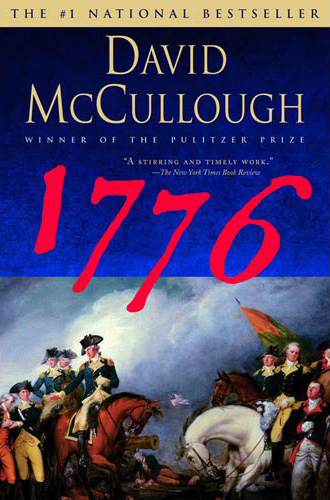 ANOTHER David McCullough!
ANOTHER David McCullough!This is, I think, his most famous book.
In terms of reading about the wars of the United States of America, I grew up most interested in the Civil War and WWII. Getting older, I've added WWI and the Vietnam War to that list. I don't remember ever learning much of anything worthwhile about any of these conflicts in school. At least not before college. I remember vocab terms like rearm and blitzkrieg, but hardly anything about the Revolutionary War. I was in a play in summer children's theatre called Yankee Doodle that covered, among other things, the midnight ride of Paul Revere (Be up! Be armed! Be about!) But nothing much in school. This is weird because it is truly an incredible story and I would imagine there's some way in hell to get kids interested in how improbable this nation's very existence is ... but oh well, whatever, never mind.
1776 covers just that. It begins with the armies in Boston and ends with them a year later in New Jersey. In the middle of all of it, the colonies declare independence. McCullough sticks close to his sources, citing lots of journals and letters in his storytelling.
You'd think focusing on just one year of the war would help to clarify things, allowing the reader to focus for a thorough understanding of one part of the overwhelming whole. But I actually felt confused over and over again while reading this book, and I think I know why:
There were no good maps.
I admit I am (embarrassingly but not permanently) ignorant of this chapter in history. I don't have the same mental landmarks as I would when reading about the Civil War or WWII. I don't know many of the dates and hardly any of the terrain involved in the Revolutionary War. But I should be able to follow the text from battle to battle and siege to siege, even if I'd never set foot on U.S. soil.
Allow me to reference another grand history: The Lord of the Rings. That trilogy is outfitted with detailed and clearly labeled maps of the relevant areas of Middle Earth. You all know the ones I'm talking about. With the Tolkien font and the Misty Mountains and blah blah blah. Through all the density of those books, you always have a place to look to when you're feeling lost. Literally.
1776 could really have benefited from a few such maps. This sounds like such an old lady gripe, but it's true. The only maps provided are hard to read, split in half by the binding, and not well captioned. So what's the point? And it's demoralizing to find your self confused geographically when the place in question is Brooklyn Heights.
So there. I will try to read another book about the American Revolution before this year is out. Hopefully I will be able to provide some more insight at that point.
Till then: this book is definitely not a throwaway. The content is so incredible, again, that it's interesting as a whole. I just couldn't delve too deep for lack of orientation.
No comments:
Post a Comment